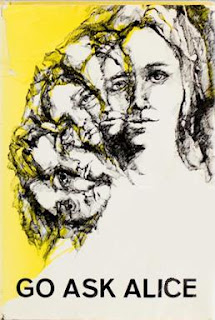The times, they indeed, were "a changin'". The 1960s saw the rise of the counterculture. Nice kids threw off societal norms, used drugs, and danced naked in fields. Parents were terrified their kids would follow suit. In 1971, Go Ask Alice, the "diary" of a young girl pedalled that fear in paperback form - but was it meant to scare kids or parents?
The book's title Go Ask Alice is a reference to the Jefferson Airplane song White Rabbit ; the song uses the plot of Alice in Wonderland as a metaphor for taking psychedelic drugs. Whether the diarist was named Alice is unclear but I will call her "Alice" for the sake of clarity. "Alice" is a 15-year-old girl whose family moves to a new town. "Alice" can't seem to fit in with the in crowd. Her diary talks about normal teen girl issues : dieting, liking boys, her relationship with her parents - until "Alice" drinks LSD laced cola at a party. Over a weekend she trips on acid and loses her virginity. So begins every parent's nightmare of their daughter :
1 - stealing pills from her grandparents
2 - selling drugs with a friend for their boyfriends
3 - catching those boyfriends engaged in gay sex and realizing those boyfriends were using them to make money
4 - being raped while on heroin
5 - coming home only to run away again
6 - performing sex acts for drugs at an outdoor concert
7 - becoming homeless
8 - coming back home and kicking drugs
9 - being drugged severely enough to be committed to a psychiatric hospital
10 - kicking drugs, finding a boyfriend
11 - being found dead by her parents
ya know, typical teen stuff. ("Alice" manages to run a successful jewelry shop during all that chaos)
The book was a phenomenal success, finding readership amongst both adults and teens. By 1979 the paperback had been reprinted 43 times. Libraries faced high demand for Go Ask Alice especially after the 1973 television movie. The book remained popular until the 1990s. Go Ask Alice received critical praise, especially because it was "authentic." In 1998 a reviewer called the book "laughably written," citing the speed with which "Alice" becomes addicted as preposterous. The book had been assigned in many schools as an anti-drug teaching tool. Teens reported relating to "Alice's" emotions far more than her urge to take drugs.
The book was championed by Art Linkletter, whose own daughter battle drugs. Beatrice Sparks, a Mormon youth pastor in her fifties, who had worked as a ghostwriter for Art Linkletter's TV show, edited the "diary" of a young female teen drug addict into a book. Sparks claimed the diary was from a real teenage girl, but refused to divulge the girl's identity. Beatrice Sparks claimed to have been a licensed psychotherapist, but no records of ever been uncovered to back up her claim. Sparks said her work with youth inspired her to help teens in a large scale way. Sparks claimed royalty payments (the book was credited to "anonymous",) but wanted her name on the cover. She began saying she edited a young girl's diary, but added the experience of teens she counselled. Sparks could not produce the actual diary at the basis of Go Ask Alice. Further editions stated the book was a work of fiction.
In 1973 the mother of a real teenager who suffered depression and committed suicide asked Sparks to edit her son's journals into a second teen helping book. Sparks took the mother's earnest plea and produced "Jay's Journal" - the "diary" of a teenage Satanist. (it is at this point I want to stop writing, bleach my brain, and beat the s**t out of Beatrice Sparks' ghost.) "Jay's" family was outraged and claimed Sparks used only 21 of 212 entries to shore up the NOT TRUE Satanism angle. "Jay's Journal" was one of the early influences of the Satanic Panic that followed in the early 1980s.
Sparks then inserted herself into stories about AIDS, gang violence, teen pregnancy, inappropriate teacher / student relationships, eating disorders, and the foster care system. None of Sparks' subsequent books hit as hard as Go Ask Alice. But why did Go Ask Alice resonate in such a big way? Was it because parents wanted insight into their children's lives? Was it because teenagers were curious about drug addiction? Perhaps the book succeeded because the girl was never given a name. She could be the parental reader's daughter, or the daughter of the smug family down the street whose child got into trouble for underage drinking. She could be the girl from your school who disappeared after rumors swirled.
Go Ask Alice as a novel most definitely of its era. Rehab didn't exist then. Addiction was seen as weakness, not a disease. By 1973, 10 years after the world so JFK shot on TV in their own homes, the world had changed so rapidly life was unrecognizable. Go Ask Alice was fear-mongering to be sure, and of the worst kind. A woman who wanted attention made up a story and packaged it as truth, as an inevitability. If you ask "Alice" she'll tell you all Go Ask Alice will "feed your head" is a ridiculous story.
ARTICLES :
Go Ask Alice. Wikipedia.


No comments:
Post a Comment